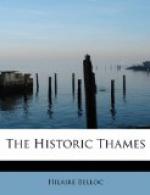One may also believe that the termination “or” or “ore” is Teutonic; Cumnor may have meant “the wayfarers’ stage,” and Windsor probably “the landing place on the winding of the river.”
Hythe also is thought to be Teutonic. One can never be quite sure with a purely Anglo-Saxon word, that it had a German origin, but at least Hythe is Anglo-Saxon, a wharf or stage; thus Bablock Hythe on the road through the Roman town of Eynsham across the river to Cumnor and Abingdon, cutting off the great bend of the river at Witham; so also the town we now call “Maidenhead,” which was perhaps the “mid-Hythe” between Windsor and Reading. Some few certainly Celtic names do survive: in the Sinodun Hills, for instance, above Dorchester; and the first part of the name Dorchester itself is Celtic. At the very head of the Thames you have Coates, reminding one of the Celtic name for the great wood that lay along the hill; but just below, where the water begins, to flow, Kemble and Ewen, if they are Saxon, are perhaps drawn from the presence of a “spring.” Cricklade may be all Celtic, or may be partly Celtic and partly Saxon. London is Celtic, as we have seen. And in the mass of places whose derivation it is impossible to establish the primitive roots of a Celtic place name may very possibly survive.
The purely Roman names have quite disappeared, and, what is odd, they disappeared more thoroughly in the Thames Valley than in any other part of England. Dorchester alone preserves a faint reminiscence of its Romano-Celtic name; but Bicester to the north, and the crossing of the ways at Alchester, are probably Saxon in the first part at least. Streatley has a Roman derivation, as have so many similar names throughout England which stand upon a “strata” or “way” of British or of Roman origin. But though “Spina” is still Speen, Ad Pontes, close by, one of the most important points upon the Roman Thames, has lost its Roman name entirely, and is known as Staines: the stones or stone which marked the head of the jurisdiction of London upon the river.
To return to the river regarded as a boundary, it is subject to this rather interesting historical observation that it has been more of a boundary in highly civilised than in barbaric times.
One would expect the exact contrary to be the case. A civilised man can cross a river more easily than a barbarian; and in civilised times there are permanent bridges, where in barbaric times there would be only fords or ferries.
Nevertheless, it is true of the Thames, as of nearly every other division in Europe, that it was much more of a boundary at the end of the Roman Empire, and is more of a strict boundary to-day, than it was during the Dark Ages, and presumably also before the Claudian invasion. Thus we may conjecture with a fair accuracy that in the last great ordering of boundaries within the Roman Empire, which was the work of Diocletian, and so much of which still survives in our European politics to-day (for instance, the boundary of Normandy), the Thames formed the division between Southern and Midland Britain. It is equally certain that it did not form any exact division between Wessex and Mercia.




